Contents
Cryptosporidiosis of calves is a type of coccidiosis specific to cattle. But, unlike the innocent bovine eimeriosis against its background, it can cause economic damage. When infected with cryptosporidium, the calf has only two options: die or recover. More than half “choose” the first.
What is the disease “cryptosporidiosis”
The causative agent is a parasitic single-celled organism that can cause lung and gastrointestinal diseases. Calves are susceptible to infection with Cryptosporidium parvum. Mostly newborns suffer from cryptosporidiosis. Profuse, watery diarrhea caused by the parasite causes dehydration and death.
Cryptosporidium provokes the development of enteritis in calves. Unlike eimeria, these unicellular organisms do not leave their “host” at the end of their life cycle. Some of them remain in the epithelial cells of the ileum and continue to live.
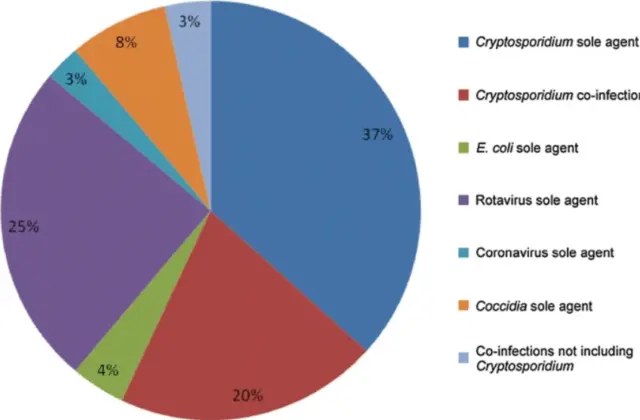
The graph shows that 57% of all intestinal diseases in young calves are due to cryptosporidiosis, “pure” or mixed with other infections.
Pathogenesis
Calves under the age of 6 weeks are most susceptible to cryptosporidiosis. This does not mean that an older animal cannot become infected with parasites. Moreover, cryptosporidium, “reached” the victim, most likely, will remain in it forever. But when infected at the age of more than 6 weeks, the disease is asymptomatic.
The “spores”-oocysts that got into the intestines of the calf pass to the second stage of development – sporozoites Cryptosporidium parvum. The latter adhere to cells in the upper small intestine. Once attached, the sporozoites form a protective “bubble” that separates the parasite from both the “external environment” and the internal contents of the host cell. The membrane created by Cryptosporidium allows it to receive nutrients from the host and protects against the host’s immune response. That is why it is so difficult to fight the causative agent of the disease.
After establishing a shelter, sporozoites turn into trophozoites, which are able to reproduce both sexually and asexually. During reproduction, 2 types of oocysts are formed. The thin-walled cells return to the intestinal epithelial cells again, infecting the host again. Thick-walled with feces are released into the external environment.
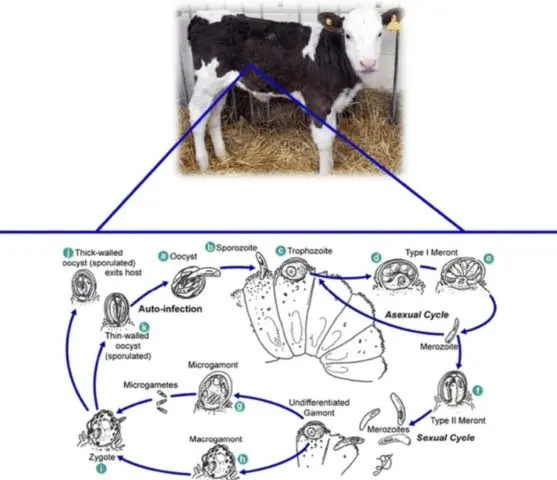
Diagram of the life cycle of cryptosporidium
Diagnosis of cryptosporidiosis in calves
The disease in cattle is caused by 4 types of cryptosporidium:
- parvum;
- bovis;
- ryanae;
- anderson.
But only the former causes disease in newborn calves and asymptomatic shedding of oocysts in older animals. Researchers believe that the distribution of different types of cryptosporidium depends on the age of the cattle. Cryptosporidium andersoni more commonly infects rennet in adult cattle. The remaining three species are “prone” to infect young animals.
The diagnosis is established in a complex way:
- symptoms;
- epizootic situation in the area;
- laboratory studies of faeces.
Excrement is examined in several ways for reliability. In two methods, the sample is stained. Oocysts in this case either do not stain at all, or weakly “take” the paint. The Darling or Fülleborn methods are also used. These methods use a saturated solution of sucrose or salt.
symptomatology
The incubation period of cryptosporidiosis in newborn calves is 3-4 days. Symptoms of C. parvum infection:
- refusal to eat;
- profuse watery diarrhea;
- dehydration;
- coma.
Into whom the calf falls if time has been lost. Due to dehydration. Diarrhea usually appears 3-4 days after infection with parasites. Duration 1-2 weeks. The release of oocysts into the external environment occurs between 4 and 12 days after infection with cryptosporidium. These spores become dangerous to healthy animals immediately after entering the external environment.
When infected with C. andersoni, to which adult animals are susceptible, reduced weight and milk yield are added to the clinical signs.

The main symptom of cryptosporidiosis in a calf is profuse diarrhea.
Biochemical indicators of blood
Infection with cryptosporidiosis can also be determined by a biochemical blood test. True, this applies more to diagnostics for the sake of determining the epizootic situation. You need to start treatment on the first day.
With cryptosporidiosis in calves, the content of total protein in the blood decreases by 9,3%, albumin – by 26,2%. This indicates a violation of the absorption of protein from the intestine and impaired liver function. The total amount of globulins in calf disease increases by 8,9%:
- α-globulin almost at the same level;
- β-globulin – higher by 21,2%;
- γ-globulin – by 8,8%.
Other indicators are also changing. According to the general results of a biochemical blood test, it can be said that when a calf is infected with cryptosporidiosis, not only the intestinal function is disturbed. Degenerative processes develop in the liver. This does not allow the body to neutralize the toxins that are formed as a result of the vital activity of parasites.
Features of the spread of the disease
Infection of newborn calves with cryptosporidium oocysts occurs either orally or in utero. Since an adult cow can also become infected with cryptosporidiosis or remain a carrier of the parasite after recovery, calves are born already sick. In this case, signs of the disease appear already from 1-2 days after birth.
Calves born healthy become infected by contact with the faeces of sick animals, by drinking water or feed contaminated with droppings. Oocysts can be everywhere in the environment if the bedding and barnyard are not kept clean.
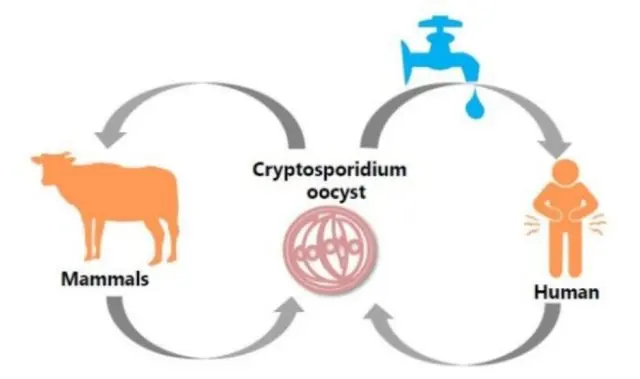
Cryptosporidiosis can be transmitted from calf to human
What is dangerous disease
Cryptosporidiosis brings not only economic losses. The study of this disease showed that not only animals, but also people are infected with parasites. Moreover, it is precisely the species C. parvum that is the main causative agent of cryptosporidiosis in young animals.
Since there is practically no time for diagnosis, owners often make the mistake of starting to treat calves for simple diarrhea, which can be caused by a queen hunt. Accordingly, the newborn either survives despite the “treatment” or dies. Mortality from dehydration among young calves reaches 60%.
How to Treat Cryptosporidiosis in Calves
There are no effective drugs against calf cryptosporidiosis. For treatment often prescribed:
- sulfadimezin;
- himcoccid;
- aprolium;
- norsulfazole;
- paromomycin.
All these drugs do not stop the course of the disease, but reduce the number of oocysts excreted by a sick calf. Himkoktsid refers to coccidiostatics. These drugs do not cure, but allow the animal to develop immunity.
Polymyxin is also recommended in combination with furazolidone for 6 days. Dose of antibiotic – 30-40 thousand units. The total volume of the composition is 6-10 mg/kg. Abroad, all these preparations for calves are not licensed.
Halofuginone lactate
The only licensed product is halofuginone lactate. At the same time, the mechanism of action of the drug is not known for certain. There is a version that it affects the sporozoite and merozoite stages of the body.
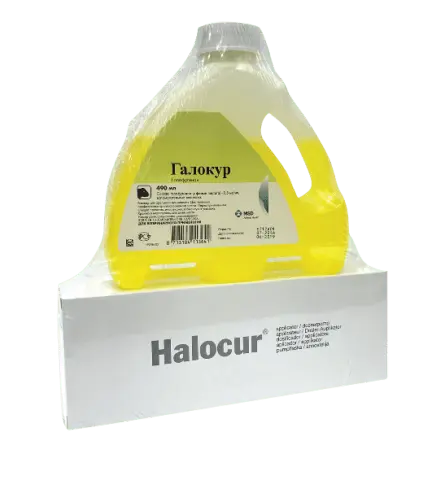
Halokur is one of the most popular brands of halofuginone lactate.
Application rules
Halofuginone lactate is used to prevent and treat cryptosporidiosis in young animals. For prophylactic purposes, the drug is used during the first 1-2 days after the birth of a calf. Treatment should begin within the first day after the onset of diarrhea. Release the drug in liquid form. The dosage is calculated individually for each calf: 0,1 mg of halofuginone per 1 kg of live weight. The concentration of the active substance in preparations of different brands may vary. The manufacturer must indicate the specific dosage of his product in the instructions.
Halofuginon is given every day at the same time. During treatment, the calf is provided with sufficient milk or colostrum. The drug is mixed into the feed for 7 days.
Prohibited
Use halofuginone lactate on debilitated animals. Give the drug to calves whose diarrhea lasts more than 24 hours. Feed the medicine before feeding.
Lactate halofuginone is not able to completely prevent infection or cure the calf, but reduces the duration of diarrhea and reduces the number of oocysts shed. Other means are even less effective.
Complementary Therapy
Although in the case of cryptosporidiosis it is more logical to call it the main one. Sick calves are provided with dietary nutrition. They make droppers with drugs that restore the water-salt balance. Enveloping decoctions are soldered.
The use of probiotics
Probiotics are also an adjunct therapy. They are unable to cure the calf. Here you can only restore the intestinal microflora that died as a result of the use of antibiotics. But there is another opinion: bacteria multiply perfectly on their own. In any case, probiotics will not make it worse.
The drugs are given orally, soldered with warm water instead of one of the feedings.
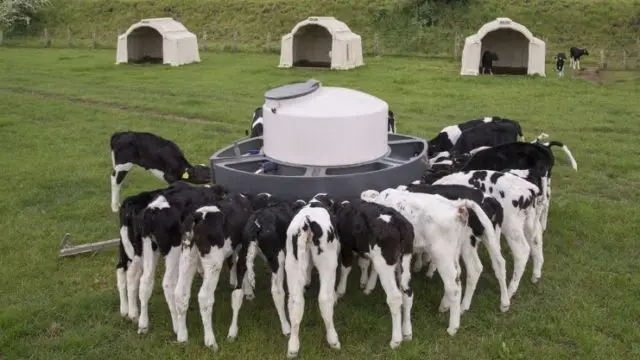
Auxiliary drugs can be added to calves during feeding or in drinkers
Preventive measures
There is no vaccine for cryptosporidiosis. They are trying to create it, but so far to no avail. Therefore, vaccinations should not be counted on.
Oocysts are very difficult to remove from the environment, so the only preventive measures can be to reduce pollution and stimulate the natural immunity of the calf.
For pregnant cows create optimal conditions for keeping and feeding. The litter is cleaned frequently and thoroughly. Calving rooms and calf houses are disinfected. There are various methods of disinfection:
- ferry;
- disinfectant based on hydrogen peroxide, formalin (10%) or ammonia (5%);
- hot water followed by surface drying;
- burning with fire.
Oocysts are sensitive to extreme temperatures: from -20 °C to + 60 °C.
Affected calves are immediately isolated. Service personnel are treated and systematically examined for the presence of cryptosporidium in the faeces.
It is also impossible to replenish the herd with animals from dysfunctional farms.
Conclusion
Cryptosporidiosis of calves is a difficult-to-treat disease transmitted to humans. Since there is no vaccine or cure for this disease, the risk of infection in calves must be minimized. This is where prevention comes into play.









